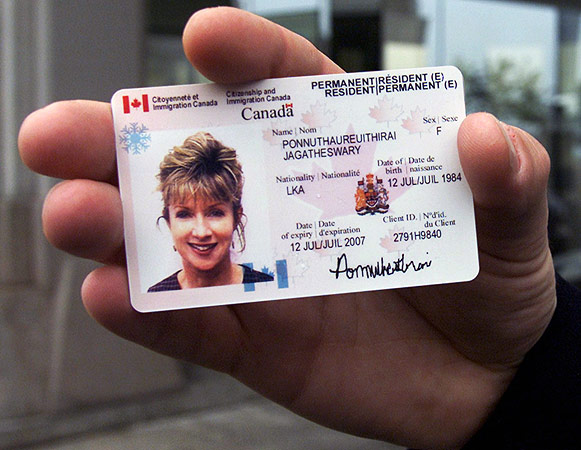The Canada Permanent Resident (PR) Card is not just a piece of identification; it’s the key to various opportunities and privileges in the land of maple leaves. As a testament to your legal status as a permanent resident of Canada, this card opens doors to a world of benefits and experiences. In this article we will cover everything you need to know About Canada PR card.

What Is a Canada PR Card?
A Canada PR Card, or Permanent Resident Card, is an essential document for permanent residents of Canada. It serves as proof of an individual’s status as a permanent resident in Canada, and it is required for re-entry into the country when traveling abroad. This card includes important details like the holder’s name, photograph, date of birth, and other identifying information.
The Canada PR Card is typically issued for a five-year period and must be renewed before it expires to maintain valid permanent resident status in the country. It’s important to note that a Canada PR Card is not a travel document for international travel to other countries; it is specifically for re-entering Canada.
Eligibility Criteria for a Canada PR Card
- Permanent Resident Status.
- Physical Presence in Canada (730 days in the last five years).
- Compliance with Residency Obligations.
- No Pending Removal Orders.
- Not Deemed Inadmissible.
- Not Under a Removal Order.
- Required Documents.
- Complete Application.
- Application Fees.
- Timely Renewal.
How To Apply for a Canada PR Card
Step 1: Gather Required Documents
Before you begin your application, make sure you have the necessary documents ready. You will need:
- A copy of your valid and current permanent resident travel document (PRTD) or travel document.
- Passport-size photos that meet the specifications provided in the application guide.
- Any additional documents requested in your application guide.
Step 2: Download the Application Package
Visit the Immigration, Refugees, and Citizenship Canada (IRCC) website to download the most recent PR Card application package (IMM 5444). This package includes the application guide and the necessary forms.
Step 3: Read the Application Guide
Thoroughly review the application guide included in the package. This guide provides detailed information on the application process, eligibility criteria, and instructions on how to complete the forms.
Step 4: Complete the Application Form
Fill out the application form (IMM 5444) according to the instructions in the application guide. Ensure all information is accurate and complete. Be particularly careful with your personal details, as mistakes may lead to delays or rejections.
Step 5: Calculate Your Fees
Consult the application guide to determine the fees required for your application. Fees are subject to change, so it’s important to verify the current fee at the time of application.
Step 6: Pay the Fees
Submit the appropriate fees for your application. Payment options and instructions can be found in the application guide. Keep a record of your payment, as you’ll need to provide proof of payment when submitting your application.
Step 7: Review Your Application
Before submitting your application, double-check that all forms are completed accurately, all required documents are included, and you’ve paid the correct fees.
Step 8: Mail Your Application
Mail your complete application package to the appropriate address, as indicated in the application guide. Be sure to use a trackable mailing method to monitor the delivery and receipt of your application.
Step 9: Wait for Processing
After submitting your application, you’ll need to wait for processing, which can take several weeks or months. You can check the status of your application online through the IRCC website.
Step 10: Attend Biometrics Appointment (If Required)
If requested by IRCC, attend a biometrics appointment at a local Application Support Center (ASC) or Visa Application Center (VAC). Biometrics may include fingerprinting and a photo.
Step 11: Respond to Requests for Additional Information (if necessary)
If IRCC requests additional information or documents, respond promptly and provide the requested materials.
Step 12: Receive Your PR Card
Once your application is approved, you will receive your Canada PR Card by mail at the address you provided in your application. The card is typically valid for five years.
Step 13: Renew Your PR Card (When Required)
Remember to renew your PR Card before it expires to maintain your permanent resident status in Canada.
Required Documents for PR Card Application
- A copy of your valid and current permanent resident travel document (PRTD) or travel document.
- Passport-size photos meeting the specifications provided in the application guide.
- Any additional documents requested in your application guide.
How To Renew or Replace Your Canada PR Card
- Eligibility Check: Verify your eligibility for renewal or replacement. This may be due to an expiring PR Card, a lost/stolen card, or errors in the card.
- Gather Documents: Collect required documents, including a copy of your valid permanent resident travel document, passport-size photos, and any additional documents specified in the application guide.
- Download Application Package: Visit the IRCC website to download the renewal or replacement application package (IMM 5444), which contains forms and instructions.
- Study the Application Guide: Thoroughly review the guide provided in the package, which offers detailed information on the process and eligibility criteria.
- Complete Application Form: Fill out the renewal or replacement form (IMM 5444) following the guide’s instructions. Accuracy is crucial to prevent delays or rejections.
- Calculate and Pay Fees: Determine the applicable fees based on the application guide and make the payment, following the provided instructions.
- Submit Application: Mail your complete application package to the specified address. Use a trackable mailing method for monitoring. Allow several weeks or months for processing and check your application status online.
READ: Out of Status in Canada: Causes, Consequences, and Solutions
How to Appeal a PR Card Application Rejection
Review the Rejection Letter
Carefully review the rejection letter sent by Immigration, Refugees, and Citizenship Canada (IRCC) to understand the reasons for the rejection. This will provide crucial insights into why your PR Card application was denied.
Determine Eligibility for Appeal
Confirm your eligibility to appeal the rejection. You can generally appeal if your PR Card application was refused for reasons related to residency obligations, criminality, or misrepresentation.
Prepare an Appeal Package
Assemble an appeal package that includes:
- A completed appeal form (available on the IRCC website).
- A copy of the rejection letter.
- A written submission outlining the reasons for your appeal, addressing the concerns raised in the rejection letter, and presenting any additional supporting documents.
Submit the Appeal Package
Send your appeal package to the Immigration Appeal Division (IAD) of the Immigration and Refugee Board (IRB). The address and specific instructions for submitting the appeal can be found in the rejection letter or on the IRCC website.
Attend the Appeal Hearing
If your appeal is accepted, you will be scheduled for an appeal hearing before the IAD. During the hearing, you will have the opportunity to present your case, respond to any questions, and provide additional documentation to support your appeal.
Await the Decision:
After the appeal hearing, the IAD will review the evidence and make a decision. If the appeal is successful, your PR Card application will be reconsidered, and you may be issued a PR Card. If the appeal is unsuccessful, you will receive a written decision explaining the outcome.
Citizenship vs. Permanent Residency: Understanding the Difference
1. Legal Status:
- Citizenship: Citizenship is the highest legal status in a country, granting individuals full political and legal rights, including the right to vote, work in government positions, and stay in the country indefinitely. It is typically acquired by birth, descent, marriage, or through naturalization.
- Permanent Residency: Permanent residency, often referred to as PR status, is a legal status that allows individuals to live and work in a foreign country for an indefinite period. However, PR status does not grant the same rights as citizenship, and PR holders may not have the right to vote or work in certain government positions.
2. Travel Rights:
- Citizenship: Citizens can usually travel with their country’s passport without restrictions. They are entitled to consular assistance and protection when abroad.
- Permanent Residency: PR cardholders can travel freely within their host country and may need additional documentation to travel internationally. They may not receive the same level of consular assistance as citizens.
3. Voting and Political Participation:
- Citizenship: Citizens have the right to vote in national elections and participate fully in the political processes of their country.
- Permanent Residency: PR cardholders may not have the right to vote in national elections and may be limited in their political participation.
4. Residency Requirements:
- Citizenship: While residency requirements may exist, they do not usually affect a citizen’s legal status. Citizens have the right to live abroad for extended periods without losing their citizenship.
- Permanent Residency: PR status typically requires individuals to maintain a certain level of physical presence in the host country. Extended absences may jeopardize PR status.
5. Revocation and Deportation:
- Citizenship: Revoking citizenship is a complex and rare process, usually linked to fraudulent acquisition or participation in severe criminal activities.
- Permanent Residency: PR status can be lost due to non-compliance with residency obligations or criminal activities. PR cardholders may be subject to deportation if their status is revoked.
6. Eligibility and Application:
- Citizenship: Eligibility for citizenship often requires meeting specific residency, language, and knowledge criteria. Application for citizenship is a separate process from permanent residency.
- Permanent Residency: The eligibility criteria for permanent residency vary by country and immigration program. It generally involves sponsorship, family reunification, or skilled migration. PR status is typically a precursor to citizenship.
7. Benefits and Social Services:
- Citizenship: Citizens have access to all social services and benefits offered by their country, including healthcare, education, and social welfare programs.
- Permanent Residency: PR cardholders usually have access to most social services but may not be eligible for certain benefits, particularly if they are new arrivals.
Benefits of Holding a Canada PR Card
- Legal Status: The PR Card confirms your legal status as a permanent resident in Canada. This status allows you to live, work, or study anywhere in Canada.
- Access to Most Social Services: As a permanent resident, you have access to most social services and benefits offered by the Canadian government, such as healthcare, education, and social welfare programs.
- Travel Flexibility: The PR Card serves as a travel document, enabling you to travel to and from Canada. It makes international travel more accessible without the need for a visa or additional travel documents.
- Family Reunification: Holding a PR Card allows you to sponsor eligible family members for permanent residency in Canada, promoting family reunification.
- Path to Citizenship: Permanent residency is often a stepping stone to Canadian citizenship. You can apply for citizenship after meeting residency and other criteria.
- Economic Opportunities: You have the opportunity to work for any employer in Canada and switch jobs without needing a new work permit.
Conclusion
Your passport to permanent residence and its benefits is the Canada PR Card (Permanent Resident Card). To keep exercising your rights as a PR cardholder, you must keep your PR status. Important steps in this process include knowing the residency criteria, keeping track of your time spent outside of Canada, and, in certain situations, applying based on compassion and humanitarianism. Equipped with this understanding, you may make well-informed choices to safeguard and improve your status as a permanent resident of Canada, guaranteeing a prosperous and safe future in our multicultural and hospitable nation.

